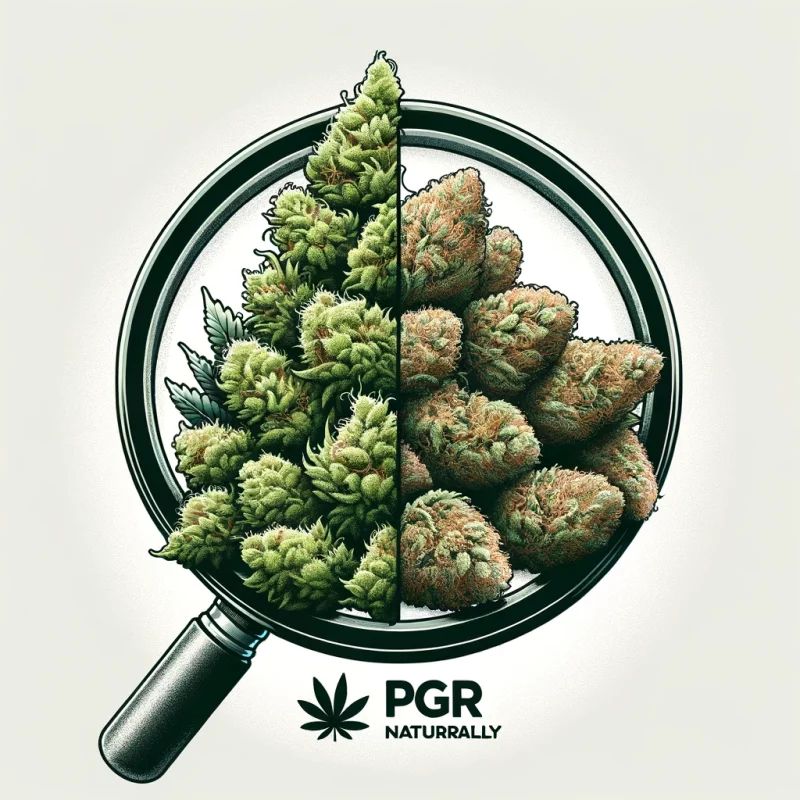FLOWER, THCA FLOWER
PGR Weed: A short guide on identifying dangerous hormones in Cannabis
Every other day I hear “Bro, I can get pounds of fire for like $700!” My response was usually ” Bro! Great! Grab me 20 pounds!” , until I learned about PGR. Now, when someone tries to negotiate the price by mentioning their Oregon connection, I have to have a serious conversation. The cost of high-quality THCa is similar to the prices in the marijuana market. If you want the best, you have to be willing to pay for it. It’s like buying organic food or quality clothing – they cost more because it’s more expensive to produce. Imagine someone offering you a Wagyu burger for the price of a Big Mac, you’d be suspicious, right? So why should cannabis be any different? Just like you don’t want hormones in your food, you don’t want them in your buds either. If it seems too good to be true, run the other way.
In the dynamic landscape of cannabis consumption, it’s essential to navigate the potential hazards associated with PGR weed for a well-informed approach to your choices. This comprehensive guide will delve into the subtle yet significant dangers linked to Plant Growth Regulators (PGRs) and empower you to make healthier decisions when it comes to cannabis.
The Hidden Dangers of PGR-Enhanced Cannabis
When exploring the world of cannabis cultivation, the use of Plant Growth Regulators (PGRs) emerges as a topic of concern. PGRs, chemicals intended to enhance plant growth and yield, have found their way into the cannabis market, raising questions about their impact on consumer health.
PGRs work by manipulating the plant’s natural growth processes, encouraging it to produce more flowers and denser buds. While this might sound appealing from a cultivation standpoint, the implications for those consuming the end product are not as rosy.

Recent studies have pointed to potential health risks associated with the consumption of PGR-infused cannabis. These risks include an increased likelihood of respiratory issues and adverse effects on the nervous system. The challenge lies in the fact that consumers often have little awareness of whether the cannabis they’re purchasing has been treated with PGRs.
Understanding the potential dangers of PGRs is the first step toward making informed choices about the cannabis you consume. While the long-term effects are still being studied, the precautionary principle suggests that minimizing exposure to potentially harmful substances is a wise approach.
Identifying PGR-Infused Marijuana: A Consumer’s Guide
As a responsible consumer, being able to identify PGR-influenced cannabis is paramount. While it may not be feasible to run chemical tests on every product you encounter, there are visual cues that can offer insights into whether the cannabis has been treated with PGRs.
- Unnaturally Dense Buds: One of the telltale signs of PGR use is excessively dense buds. While dense buds are often associated with high-quality cannabis, those treated with PGRs may have an unnatural, compact appearance.
- Lack of Aroma: PGRs can affect the plant’s ability to produce the rich, varied terpene profiles that contribute to the characteristic aroma of different cannabis strains. If the cannabis you’re considering lacks a distinct and robust scent, it could be an indicator of PGR use.
- Unusual Growth Patterns: PGRs can alter the natural growth patterns of cannabis plants. Look for irregularities in the structure of the plant, such as unnaturally short internodes or uneven spacing between branches.
Understanding product labels is another valuable aspect of being an informed consumer. Unfortunately, regulations around PGR disclosure in the cannabis industry can be inconsistent. However, some producers committed to transparency may include information about cultivation practices on their labels. Look for terms like “organic,” “sustainably grown,” or “PGR-free” when making your purchase.
Growing Cannabis Safely: PGR-Free Alternatives
For those with a green thumb or aspiring cultivators, the quest for PGR-free cannabis extends to the cultivation process. Fortunately, growing cannabis without the use of PGRs is not only possible but also contributes to a safer and more natural end product.
- Organic Nutrients: Embrace organic nutrient solutions that nourish your cannabis plants without resorting to synthetic growth enhancers. This approach promotes a more natural growth cycle and enhances the overall quality of the cannabis you cultivate.
- Choose PGR-Free Seeds: The foundation of a PGR-free cultivation journey begins with the seeds you choose. Opt for reputable seed banks that prioritize organic and natural cultivation practices.
- Proper Pruning Techniques: Instead of relying on PGRs to manipulate plant structure, adopt proper pruning techniques. Pruning encourages optimal growth patterns and ensures that each bud receives adequate light and airflow.
By adopting these practices, you not only contribute to your well-being but also promote sustainable and ethical cultivation methods within the cannabis community.
In conclusion, understanding the potential risks associated with PGR weed empowers consumers and cultivators alike to make choices aligned with health and sustainability. Whether you’re navigating the dispensary shelves or tending to your cannabis garden, this guide equips you with the knowledge needed to prioritize PGR-free alternatives and promote a safer cannabis experience.
PGR Weed: A short guide on identifying dangerous hormones in Cannabis
For those with a green thumb or aspiring cultivators, the quest for PGR-free cannabis extends to the cultivation process. Growing cannabis without the use of PGRs is not only possible but also contributes to a safer and more natural end product. By adopting these practices, you not only contribute to your well-being but also promote sustainable and ethical cultivation methods within the cannabis community. Understanding the potential risks associated with PGR weed empowers consumers and cultivators alike to make choices aligned with health and sustainability. Whether you’re navigating the dispensary shelves or tending to your cannabis garden, this guide equips you with the knowledge needed to prioritize PGR-free alternatives and promote a safer cannabis experience.


